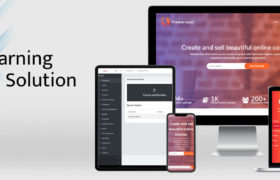Cloud computing security, often referred to as cloud security, is the collection of policies, technologies, controls, and practices designed to protect cloud-based systems, data, and infrastructure from cyber threats. As more organizations move their workloads to the cloud, ensuring security becomes a top priority.
Cloud security is essential for:
-
Protecting sensitive data from breaches and leaks.
-
Preventing unauthorized access to cloud applications and services.
-
Ensuring business continuity by safeguarding against cyber threats.
With cyberattacks on the rise, businesses must adopt strong cloud security measures to mitigate risks and maintain trust with their users.
Understanding Cloud Security Threats
Common Cyber Threats in the Cloud
The cloud environment is a prime target for cybercriminals. Some of the most prevalent threats include:
-
Data breaches – Unauthorized access to sensitive data stored in the cloud.
-
Malware attacks – Harmful software targeting cloud infrastructure.
-
Account hijacking – Stolen credentials leading to unauthorized access.
-
DDoS (Distributed Denial of Service) attacks – Overloading cloud servers to disrupt operations.
Data Breaches and Unauthorized Access
One of the biggest concerns for cloud users is data breaches. Cybercriminals exploit vulnerabilities in security settings, weak passwords, or unpatched systems to gain access to sensitive data. Organizations must implement strong identity and access management (IAM) solutions to prevent unauthorized access.
Key Components of Cloud Security
To ensure a secure cloud environment, organizations should focus on the following core security components:
Identity and Access Management (IAM)
IAM controls who has access to cloud resources. It includes:
-
Multi-Factor Authentication (MFA) – Requires multiple authentication factors.
-
Role-Based Access Control (RBAC) – Restricts access based on user roles.
-
Single Sign-On (SSO) – Simplifies access management.
Encryption and Data Protection
Encryption ensures that even if data is intercepted, it remains unreadable. Best practices include:
-
End-to-end encryption for data in transit and at rest.
-
Tokenization to replace sensitive data with non-sensitive placeholders.
Network Security Measures
Cloud networks must be secured using:
-
Firewalls to block malicious traffic.
-
Intrusion Detection Systems (IDS) to identify threats.
-
Virtual Private Networks (VPNs) for secure remote access.
Types of Cloud Security Models
Cloud security varies depending on the type of cloud model:
Public vs. Private vs. Hybrid Cloud Security
-
Public Cloud Security – Managed by third-party providers; requires robust security policies.
-
Private Cloud Security – More control over security, ideal for sensitive data.
-
Hybrid Cloud Security – Combines both, requiring integrated security measures.
Shared Responsibility Model in Cloud Security
Cloud security follows a shared responsibility model, meaning:
-
Cloud providers secure the infrastructure.
-
Users secure data, applications, and access controls.
Cloud Security Best Practices
Implementing Multi-Factor Authentication
MFA enhances security by requiring multiple verification steps, reducing the risk of compromised credentials.
Regular Security Audits and Compliance Checks
Conducting regular security audits ensures compliance with industry standards like:
-
ISO 27001 for information security management.
-
SOC 2 for cloud security best practices.
Role of AI and Automation in Cloud Security
How AI Improves Threat Detection
Artificial intelligence (AI) helps detect and respond to threats in real time. AI-powered security tools analyze patterns and identify anomalies faster than traditional methods.
Automating Security Operations
Automation reduces human error by:
-
Automatically patching vulnerabilities before exploitation.
-
Enforcing security policies across cloud environments.
Cloud Security Compliance and Regulations
GDPR, HIPAA, and Other Regulations
Compliance with GDPR (General Data Protection Regulation) and HIPAA (Health Insurance Portability and Accountability Act) is critical for cloud security.
Compliance Challenges for Cloud Users
Organizations must navigate challenges such as:
-
Data residency laws – Some countries restrict where data can be stored.
-
Vendor compliance – Ensuring cloud providers meet regulatory requirements.
Cloud Security Tools and Technologies
Firewalls, IDS, and SIEM
Security tools help monitor and protect cloud environments, including:
-
Firewalls – Block malicious traffic.
-
Intrusion Detection Systems (IDS) – Detect and prevent cyber threats.
-
Security Information and Event Management (SIEM) – Provides real-time security analytics.
Role of Cloud Access Security Brokers (CASBs)
CASBs act as intermediaries between cloud users and providers, offering:
-
Visibility into cloud applications.
-
Threat protection for cloud workloads.
Challenges in Cloud Security
Misconfigurations and Human Errors
Misconfigured security settings are a leading cause of cloud breaches. Organizations must:
-
Regularly review access permissions.
-
Use automated security configuration tools.
Insider Threats in Cloud Environments
Employees or contractors with access to sensitive data can pose security risks. Best practices include:
-
Monitoring user activities.
-
Restricting access based on the principle of least privilege (PoLP).
The Future of Cloud Security
Emerging Trends and Technologies
Future advancements in cloud security include:
-
Zero Trust Architecture (ZTA) – Verifying every user and device before granting access.
-
Quantum encryption – A new frontier in cybersecurity.
How Organizations Can Prepare
Businesses should:
-
Stay updated on security trends.
-
Invest in cybersecurity training for employees.
Conclusion
Cloud computing security is a critical aspect of digital transformation. By implementing best practices, leveraging AI, and staying compliant, organizations can minimize risks and protect their data in the cloud.
Frequently Asked Questions (FAQs)
-
What is the biggest threat to cloud security?
-
Data breaches and unauthorized access are among the top threats.
-
-
How can businesses secure their cloud infrastructure?
-
By using encryption, IAM, firewalls, and regular audits.
-
-
What is the shared responsibility model in cloud security?
-
It defines which security tasks are managed by cloud providers and which are the user’s responsibility.
-
-
How does AI help in cloud security?
-
AI detects threats in real-time and automates security responses.
-
-
What are the best compliance standards for cloud security?
-
GDPR, HIPAA, and ISO 27001 are widely recognized.
-




